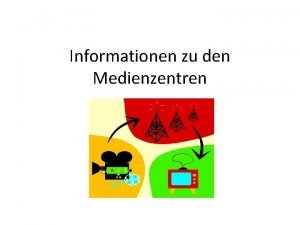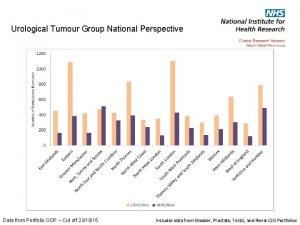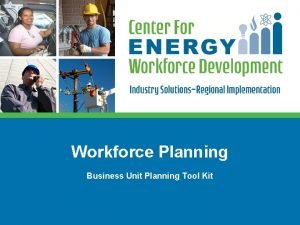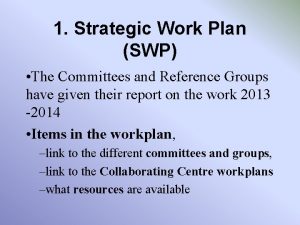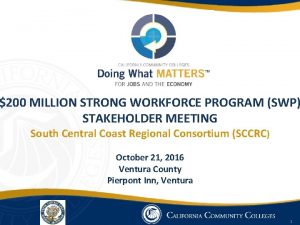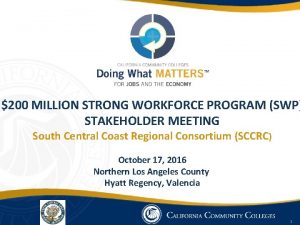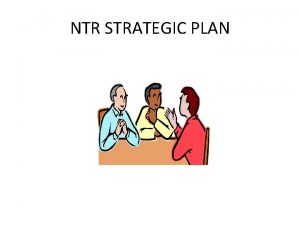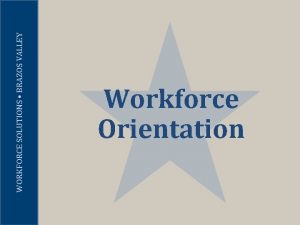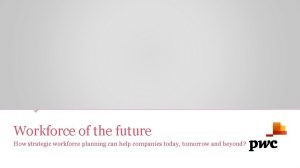IFADs Strategic Workforce Plan The SWP in IFADs

















- Slides: 17

IFAD’s Strategic Workforce Plan

The SWP in IFAD’s planning and performance management system • The SWP is IFAD’s first exercise in planning human resources from an overall corporate perspective • It is the missing element of a comprehensive results planning and performance management system comprised of: – The results measurement framework – The strategic framework – The medium term plan – The results-based/zero-based budget

The objective of the SWP • To align human resources (numbers, skills and location) with the achievement of the results articulated in the RMF: – Greater development results – Greater institutional efficiency

The approach • Define the current situation of alignment with development objectives and efficiency, taking into account evolving operational requirements • Specify the workforce profile that we need to have to achieve objectives • Lay out the path from where we are to where we want to be

The current situation – operational area • IFAD has: – Increased the total workforce in programmes (to about 63 per cent of the total workforce) – Increased the segment of the operational workforce based in IFAD country offices (about 80 staff today) – Increased functional training and skill development for operational staff

PMD and Non-PMD Workforce FTEs (staff, temporary staff and consultants)

Strategic issues in the operational workforce • Key strategic and medium-term requirements are for: – Further growth in professional staffing in operations (particularly to support the growing programme of work, as well as implementation support and supervision roles) – Greater percentage of professional operational staff to be based in ICOs – Reduced dependence on consultants and temporary staff – More structured careers oriented to learning and skill development

PMD professional staff: HQ and ICO (October 2010)

Priority objectives for the operational workforce • Growth in professional staff in the ICOs (including greater out-posting of country programme managers in ICOs) • Integration of some functions performed by consultants and temporary staff into the regular professional staff cadre • Focus on capacity development capitalizing on rotation among regions and between HQ and ICOs

The non-operational workforce: trends • Size has remained static while operational workforce has increased quickly • The level of support activities provided by this workforce has risen dramatically • IFAD is approaching the RMF target of a maximum of 35 per cent of the workforce in non-operational roles • In many areas the workload is approaching unsustainable levels

Strategic issues for the nonoperational workforce • In spite of high workload, the level of this segment may need to be reduced – – To contain costs – To shift more resources into the operational area • There is an emerging gap between the existing skill mix and the professional requirements of important areas of activity

Issues cutting across both areas • High ratio between general service and professional staff (approximately 1: 1) – (but less if the large professional consultant workforce is taken into account – and if the phenomenon of mis-classification is recognized) • High cost of staff in certain segments – relative to comparators

Priority objectives in non-operational areas • Reduce the ratio between non-operational and operational workforce • Reduce the ratio between general service and professional staff • Improve the skills mix in key functional areas – Financial administration – Human resource management • Contain costs to allow resource shifts to the operational area

Immediate actions in relation to nonoperational workforce and crosscutting issues • Accelerate rotation to better fit skills to corporate requirements (including from nonoperational to operational areas) • Freeze recruitment against general service positions from outside IFAD • Freeze automatic pay increases

Strategic actions in non-operational areas • Reduce the requirement for labour: – Process streamlining – Systematic business process automation • Reduce the unit cost of labour: – Take advantage of decentralization and outsourcing – Better align unit labour costs with comparators • Raise the professional component through rotation, recruitment and re-training

Towards a changed workforce profile

Next steps • Align staffing budgets with general thrusts of strategy • Finalize and approve departmental and divisional level plans (supported by job audits) for: – – Necessary staffing level (with qualifications and location) Rotation Training Recruitment • Ensure compliance of all human resource management actions with approved plans • Implement the Action Plans described in tables 9, 10, and 11 • Use the new human resource management tools to achieve change
 Strategic workforce planning swp
Strategic workforce planning swp Tems swp
Tems swp Kappa alpha psi moratorium
Kappa alpha psi moratorium Medienzentrum kaiserslautern
Medienzentrum kaiserslautern Odp/swp
Odp/swp Ema/chmp/cvmp/swp/169430/2012
Ema/chmp/cvmp/swp/169430/2012 Workforce tool set
Workforce tool set Strategic workforce
Strategic workforce Strategic fit vs strategic intent
Strategic fit vs strategic intent Strategic complements and substitutes examples
Strategic complements and substitutes examples Strategic competitiveness
Strategic competitiveness Tows matrix
Tows matrix Hát kết hợp bộ gõ cơ thể
Hát kết hợp bộ gõ cơ thể Frameset trong html5
Frameset trong html5 Bổ thể
Bổ thể Tỉ lệ cơ thể trẻ em
Tỉ lệ cơ thể trẻ em Gấu đi như thế nào
Gấu đi như thế nào Tư thế worms-breton
Tư thế worms-breton



